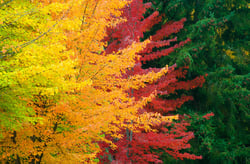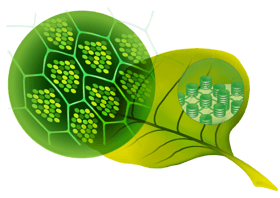We know how mesmerizing the changing leaves are in the Fall, lining the New England roads and blanketing the Pacific Mountains in multi-color tapestries. We know how the air feels cooler and crisper, we know how summer vacation ends and school begins, and we know that some birds fly south while some animals prepare for the new season in their own ways... But how do these things connect to the addition of red, orange, and golden hues in nature's forest paint palette?
Is it the cold air? The decreasing sunlight? A chemical reaction? Read below for an explanation of the science behind the changing colors of leaves in the Fall.

The decreasing hours of sunlight during Autumn days, the change in weather and temperature, and the pigments unique to certain types of leaves are all factors that contribute to the changing of the leaves' colors, but the natural process of trees preparing for winter is the root (no pun intended) cause. Trees' leaves are not strong enough to survive the winter, so the tree prepares for the cold and harsh conditions by taking all the useful things from the leaves and then letting them fall.1 During this process, the green color of leaves will change.
 The Biochemical Process
The Biochemical Process Leaves contain a pigment called chlorophyll, which gives leaves their green color and is used to convert sunlight into energy (sugars) for the tree through a chemical reaction called photosynthesis. With less sun and more cold, plants stop making chlorophyll, and trees take the important nutrients in the chlorophyll, like nitrogren, out of the leaves. Carbohydrates in the leaf are transferred into the trees' branches and no new minerals are brought in.1 Since chlorophyll gives leaves their green color, when the chlorophyll is gone and the leaf is getting ready to fall, other pigments already existing in the leaf are unmasked and can finally show through.2
In deciduous trees' leaves, there are a handful of biological pigments (also known as "biochromes"), which are molecular substances that manifest in living things as specific colors by absorbing or reflecting wavelengths of light.3 There are carotenoids like xanthophylls (yellows) and carotenes (oranges), and anthocyanins. Carotenoids produce yellow, orange, and brown colors. Anthocyanins are responsible for purple and red colors; these pigments are only produced in the fall when it is bright and cold, and are formed by trapped sugar in the leaves' veins.1
 Leaf colors are characteristic of certain species of trees, because different trees have different proportions of pigments and amounts of chlorophyll left. Anthocyanin combined with chlorophyll will make a brown color, while anthocyanins along with carotenoids create orange leaves.1 Check out this list of tree types and colors you can expect from the leaves of each:
Leaf colors are characteristic of certain species of trees, because different trees have different proportions of pigments and amounts of chlorophyll left. Anthocyanin combined with chlorophyll will make a brown color, while anthocyanins along with carotenoids create orange leaves.1 Check out this list of tree types and colors you can expect from the leaves of each:
Oak: red, brown, russet
Hickory: golden bronze
Aspen and Yellow-Poplar: golden yellow
Dogwood: purple-red
Beech: light tan
Sourwood and Black Tupelo: crimson
Red Maple: brilliant scarlet
Sugar Maple: orange-red
Black Maple: glowing yellow2
Do you have a favorite? We love them all—there's no need to choose just one! We hope you'll get the chance to step outside this week and enjoy the full spectrum of Mother Nature's Autumn color palette, while knowing the science behind how it all came to be!
1 https://www.zmescience.com/ecology/autumn-leaves-color-432432/
2 https://www.fs.usda.gov/visit/fall-colors/science-of-fall-colors
3 https://www.treehugger.com/why-do-leaves-change-color-autumn-4869632